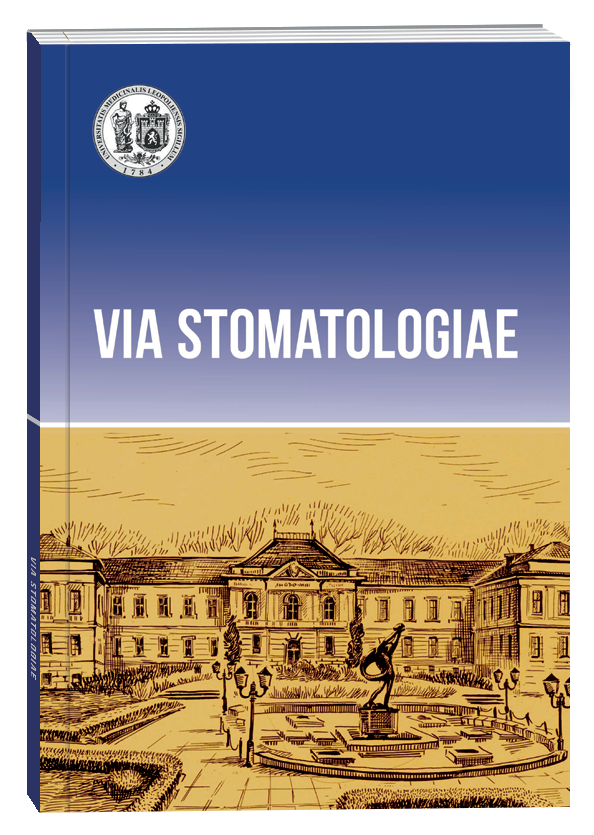ДОСЛІДЖЕННЯ СТРЕСОВИХ РЕАКЦІЙ У КРОВІ ХВОРИХ З ПОЄДНАНОЮ ТРАВМОЮ СЕРЕДНЬОЇ ЗОНИ ОБЛИЧЧЯ ТА ЗАСТОСУВАННЯ В РЕАБІЛІТАЦІЙНИЙ ПЕРІОД ТРАНСКРАНІАЛЬНОЇ ЕЛЕКТРОСТИМУЛЯЦІЇ
DOI:
https://doi.org/10.32782/3041-1394.2024-1.2Ключові слова:
транскраніальна електростимуляція, черепно-мозкова травмаАнотація
Метою досліджень було порівняння ефективності застосування транскраніальної електростимуляції для нормалізації регуляторних функцій ЦНС у післяопераційному періоді лікування хворих із травмами кісток середньої зони обличчя. Методи дослідження. Дослідження проводилися у 47 хворих із поєднаною травмою середньої зони обличчя, для якої була характерна наявність легкого черепно-мозкового ушкодження (струс головного мозку, забій головного мозку легкого ступеня тяжкості) та тяжке пошкодження лицьового скелета (1, 3, 4, 7 класи за класифікацією Ю.І. Бернадського). Усі хворі після проведеного відповідного хірургічного лікування були поділені на дві групи. Для реабілітації хворих контрольної групи застосовували консервативне лікування за традиційною схемою (22 хворих). Така сама схема застосовувалася і при лікуванні хворих основної групи (25 хворих), але додатково вона доповнювалася курсом транскраніальної електростимуляції, яку проводили за допомогою низькочастотного приладу електротерапії «Радіус-01 ФТ». Параметри роботи транскраніальної електростимуляції становили ДПС = 5%, 70 Гц, 0.11 мс із тривалістю сеансу 35 хв 1 раз на добу з курсом лікування 10 днів. Термінами спостереження ефекту її впливу на резистентність організму до дії стресових факторів було обрано 7 та 14 добу, як показниками – гематологічні дослідження визначення вмісту β-ендорфінів, АКТГ та кортизолу, віднімання стресового індексу Гаркаві. Наукова новизна. Дослідження показали, що застосування транскраніальної електростимуляції сприяло нормалізації тонусу механізмів антистресового захисту, стимулювало ендорфінові структури головного мозку і зменшувало інтенсивність больового синдрому у пацієнтів з поєднаною травмою середньої ділянки обличчя. Вже на 7-му добу вміст стрес-лімітуючих гормонів β-ендорфінів у плазмі крові хворих основної групи був вищим порівняно з контрольною (15,4 ± 1,8 пг/мл до 12,73 ± 1,6 пг/мл з р > 0,05). Висновки. Отримані дані свідчать про позитивний терапевтичний ефект транскраніальної електростимуляції на стрес-лімітуючу ендогенну опіатну систему.
Посилання
Amar Sarkar, Roi Cohen Kadosh. Transcranial electrical stimulation and numerical cognition. Can J Exp Psychol. 2016 Mar. V. 70 (1). P. 41–58. doi: 10.1037/cep0000064.
Anli Liu, Mihály Vöröslakos, Greg Kronberg, Simon Henin, Matthew R Krause, Yu Huang et al. Immediate neurophysiological effects of transcranial electrical stimulation. Nat Commun. 2018 Nov. V. 9 (1). P. 5092. doi: 10.1038/s41467-018-07233-7.
Antal A., Alekseichuk I., Bikson M., Brockmöller J., Brunoni A. R., Chen R. et al. Low intensity transcranial electric stimulation: Safety, ethical, legal regulatory and application guidelines. Clin Neurophysiol. 2017 Sep. V. 128 (9). P. 1774-1809. doi: 10.1016/j.clinph.2017.06.001.
Balevivtin А. B., Holovko K. P., Maday D. Yu. Modern techniques of improvement of treatment of victims with cranio-facial injuries. Journal of Russian military-medical academy. 2009. 1: 963–964.
Boymuradov S.A. Comparative analysis of treatment results in patients with combined nasal bone trauma and brain injuries. Russian Otolaryngology. 2009. 3: 31–33.
Brita Fritsch, Anne-Kathrin Gellner, Janine Reis. Transcranial Electrical Brain Stimulation in Alert Rodents. J Vis Exp. 2017 Nov. V. 129. P. 56242. doi: 10.3791/56242.
Cassandra D Solomons, Vivekanandan Shanmugasundaram. A review of transcranial electrical stimulation methods in stroke rehabilitation. Neurol India. 2019 Mar-Apr. V. 67(2). P. 417–423. doi: 10.4103/0028-3886.258057.
Fertonani A., Miniussi C. Transcranial Electrical Stimulation: What We Know and Do Not Know About Mechanisms. Neuroscientist. 2017 Apr. V. 23(2). P. 109–123. doi: 10.1177/1073858416631966.
Hamed Ekhtiari, Hosna Tavakoli, Giovanni Addolorato et al. Transcranial electrical and magnetic stimulation (tES and TMS) for addiction medicine: A consensus paper on the present state of the science and the road ahead. Neurosci Biobehav Rev. 2019 Sep. V. 104:118–140. doi: 10.1016/j.neubiorev.2019.06.007.
Hryhoryeva І.А., Kufterina N.S. Clinical and diagnostic peculiarities of patients in different periods of light scull-brain trauma. Ukrainian Journal of Psychoneurology. 2012. 20 (4): 9–12.
Kampschoff J. L., Cogbill T. H., Mathiason M. A. Cranial nerve injuries are associated with specific craniofacial fractures after blunt trauma. Am Surg. 2010. Vol. 76, № 11. P. 1223–1227.
Karpov А. S., Rarpov S. М., Vyshlova E. А. Prosopalgia afrer maxilla-facial trauma as factor of psychoneurological violation. Clinical dentistry. 2017. 4: 50–52.
Marom Bikson , Pnina Grossman , Chris Thomas, Adantchede Louis Zannou, Jimmy Jiang et al. Safety of Transcranial Direct Current Stimulation: Evidence Based Update 2016. Brain Stimul. Sep-Oct 2016. V. 9(5). P. 641–661. doi: 10.1016/j.brs.2016.06.004.
Marom Bikson, Zeinab Esmaeilpour, Devin Adair, Greg Kronberg, William J Tyler, Andrea Antal et al. Transcranial electrical stimulation nomenclature. Brain Stimul. 2019 Nov-Dec. V. 12(6). P. 1349–1366. doi: 10.1016/j.brs.2019.07.010.
Modabber А., Rana M., Ghassemi A. Threedimensional evaluation of postoperative swelling in treatment of zygomatic bone fractures using two different cooling therapy methods: a randomized, observer-blind, prospective study. Trials. 2013. № 14. 10 p.
Nyeonju Kang, Jeffery J Summers, James H Cauraugh. Non-Invasive Brain Stimulation Improves Paretic Limb Force Production: A Systematic Review and Meta-Analysis. Brain Stimul. 2016 Sep-Oct. V. 9(5). P. 662–670. doi: 10.1016/j.brs.2016.05.005.
Perrein A., Petry L., Reis A., Baumann A., Mertes P., Audibert G. Cerebral vasospasm after traumatic brain injury: an update. Minerva Anestesiol. 2015 Nov. V. 81(11). P. 1219–28.
Rohrich R. J., Hackney F. L., Parikh R. S. Superior orbital fissure syndrome: current management concepts. J Craniomaxillofac Trauma. 1995. V. 1 (2). P. 44–48.
Schneider H.J., Kreitschmann-Andermahr I., Ghigo E. Hypothalamopituitary disfunction following traumatic brain injury and aneurysmal subarachnoid hemorrhage: a systematic review. J Am Med Ass. 2007. № 298. P. 1429–1438.
Tarek K Rajji. Transcranial Magnetic and Electrical Stimulation in Alzheimer’s Disease and Mild Cognitive Impairment: A Review of Randomized Controlled Trials. Clin Pharmacol Ther. 2019 Oct. V. 106 (4). P. 776–780. doi: 10.1002/cpt.1574.
Thusharika D Dissanayaka, Maryam Zoghi, Michael Farrell, Gary F Egan, Shapour Jaberzadeh. Sham transcranial electrical stimulation and its effects on corticospinal excitability: a systematic review and meta-analysis. Rev Neurosci. 2018 Feb. V. 29 (2). P. 223–232. doi: 10.1515/revneuro-2017-0026.
Yennurajalingam S., Kang D-H., Hwu W-J., Padhye N.S., Masino Ch., Dibaj S.S. et al. Cranial Electrotherapy Stimulation for the Management of Depression, Anxiety, Sleep Disturbance, and Pain in Patients With Advanced Cancer. P. A Preliminary Study. J Pain Symptom Manage. 2018 Feb. V. 55 (2). P. 198–206. doi: 10.1016/j.jpainsymman.2017.08.027.







